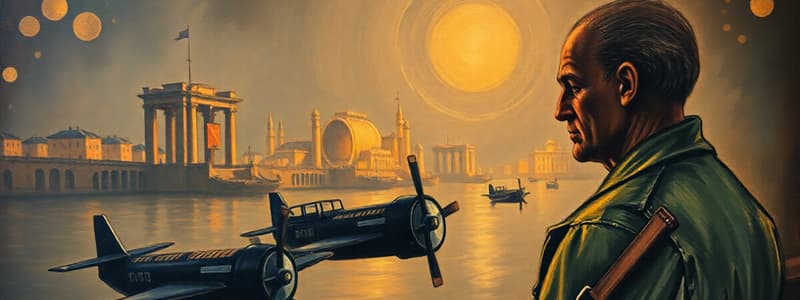Podcast
Questions and Answers
Which scientist proposed the existence of the neutrino?
Which scientist proposed the existence of the neutrino?
- Kathleen Lonsdale
- Wolfgang Pauli (correct)
- Linus Pauling
- Werner Heisenberg
Which scientist worked on reconciling genetics with Darwin's theory of evolution?
Which scientist worked on reconciling genetics with Darwin's theory of evolution?
- Howard Aiken
- Theodosius Dobzhansky (correct)
- Linus Pauling
- Werner Heisenberg
Who was awarded a Nobel Prize in Physics in 1945?
Who was awarded a Nobel Prize in Physics in 1945?
- Wolfgang Pauli (correct)
- Theodosius Dobzhansky
- Linus Pauling
- Kathleen Lonsdale
Which scientist was involved with the development of the Harvard Mark I computer?
Which scientist was involved with the development of the Harvard Mark I computer?
Who is known for contributing to quantum mechanics in chemistry?
Who is known for contributing to quantum mechanics in chemistry?
Which scientist is associated with the Copenhagen interpretation of quantum mechanics?
Which scientist is associated with the Copenhagen interpretation of quantum mechanics?
Which scientist developed rules for finding the structure of ionic crystals?
Which scientist developed rules for finding the structure of ionic crystals?
Which scientist's work involved experiments with fruit flies?
Which scientist's work involved experiments with fruit flies?
Which scientist developed expertise in crystallography under William Henry Bragg?
Which scientist developed expertise in crystallography under William Henry Bragg?
Who was closely associated with Grace Hopper in his work?
Who was closely associated with Grace Hopper in his work?
Flashcards
Wolfgang Pauli
Wolfgang Pauli
Austrian physicist known for atomic structure and the Pauli exclusion principle.
Pauli exclusion principle
Pauli exclusion principle
No two fermions can occupy the same quantum state simultaneously.
Theodosius Dobzhansky
Theodosius Dobzhansky
Russian geneticist who bridged genetics and evolution through fruit fly studies.
Howard Aiken
Howard Aiken
Signup and view all the flashcards
Harvard Mark I
Harvard Mark I
Signup and view all the flashcards
Werner Heisenberg
Werner Heisenberg
Signup and view all the flashcards
Heisenberg uncertainty principle
Heisenberg uncertainty principle
Signup and view all the flashcards
Linus Pauling
Linus Pauling
Signup and view all the flashcards
The Nature of the Chemical Bond
The Nature of the Chemical Bond
Signup and view all the flashcards
Kathleen Lonsdale
Kathleen Lonsdale
Signup and view all the flashcards
Study Notes
World War II Research Funding
- Governments increased research funding during WWII to gain tactical advantages.
- Intense competition among scientists led to valuable discoveries, benefiting both military and civilian applications.
- Research efforts continued after the war's conclusion.
Scientists and Their Contributions
- Wolfgang Pauli: Austrian-born Swiss/American theoretical physicist, known for the Pauli exclusion principle, describing atomic structure. Devised model explaining metal properties and proposed the neutrino. Awarded Nobel Prize in Physics 1945.
- Theodosius Dobzhansky: Russian population geneticist, bridging gap between genetics and evolution. Showed how mutations create diversity, impacting natural selection. Utilized fruit fly experiments.
- Howard Aiken: American electrical engineer, developed the Harvard Mark I computer in 1944. This innovative machine, a mix of electric and mechanical components, demonstrated programmable, automated calculations, setting a stage for modern computers. Collaborated with Grace Hopper on programming.
- Werner Heisenberg: German physicist. Known for his work on quantum mechanics, the Copenhagen interpretation, and the uncertainty principle. Studied mathematics and physics at universities in Munich and Göttingen.
- Linus Pauling: American chemist, winner of two Nobel Prizes (Chemistry and Peace). Key proponent of quantum mechanics in chemistry. His influential book, "The Nature of the Chemical Bond" (1939), described ionic crystal structures and covalent bonding principles.
- Kathleen Lonsdale: British crystallographer, worked under William Bragg at the Royal Institution in London. Her work involved crystal structure determinations and covalent bonding studies.
Studying That Suits You
Use AI to generate personalized quizzes and flashcards to suit your learning preferences.




